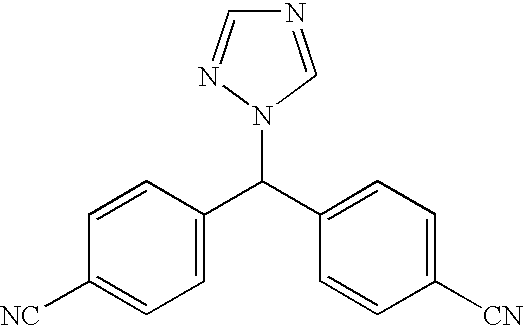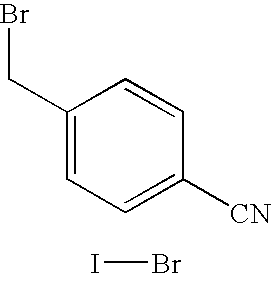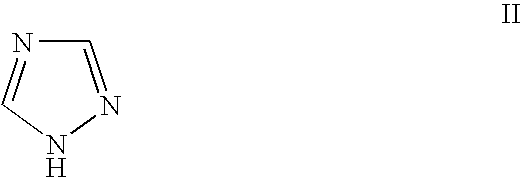Process for the preparation of letrozole
a technology of letrozole and process, which is applied in the field of process for the preparation of letrozole, can solve the problems of contaminating letrozole, tedious process, unattractive commercially, etc., and achieves the effects of contaminating letrozole, contaminating letrozole, and undesirable commercial us
- Summary
- Abstract
- Description
- Claims
- Application Information
AI Technical Summary
Problems solved by technology
Method used
Image
Examples
example 1
Preparation of Intermediate III
[0069]A glass reactor was charged with 55 grams of 1H-1,2,4-triazole, 52.6 grams of potassium hydroxide, and 250 grams of methanol, and heated to 60° C. until a solution formed. The solution was concentrated under vacuum to a semi-crystalline residue of 1,2,4-triazolylpotassium. Then, 250 grams of dimethylformamide were added, and the mixture was further concentrated to remove methanol and water. The mixture was then diluted with 1125 grams of dimethylformamide, and the mixture was cooled to a temperature of −10° C. While maintaining the temperature of the mixture below 5° C., 125 grams of 4-(bromomethyl)benzonitrile were added in portions. After a period of 30 minutes, the reaction mixture, comprising intermediate III and isomer IV impurity in a ratio of 90:9, was concentrated under vacuum to a weight of 325 grams, and then diluted with 625 grams of water, containing 188 grams of sodium chloride. After the addition of the sodium chloride solution, 125...
example 2
Preparation of Intermediate III
[0070]A glass reactor was charged with 46.2 grams of 1H-1,2,4-triazole, 44.2 grams of potassium hydroxide, and 250 grams of methanol, and heated to 60° C., until a solution was obtained. The solution was concentrated under vacuum to a semi-crystalline residue of 1,2,4-triazolylpotassium. Then, 250 grams of dimethylformamide were added, and the mixture further concentrated to remove the methanol and water. The mixture was diluted with 1125 grams of dimethylformamide, and the temperature was adjusted to −10° C. While maintaining the temperature below 5° C., 125 grams of 4-(bromomethyl)benzonitrile were added in portions. After a further 30 minutes, the reaction mixture, containing a ratio of intermediate III to unwanted isomer IV of 90.6:9.4, was concentrated under vacuum to a weight of 300 grams, and diluted with 625 grams of water containing 188 grams of sodium chloride. Then, 1250 grams of toluene were added, the mixture was stirred for 30 minutes at ...
example 3
Preparation of Intermediate III
[0071]A glass reactor was charged with 1 gram of 4-(bromomethyl)benzonitrile and 50 grams of dimethylacetamide, and the temperature was adjusted to 0° C. Then, 0.57 grams of 1,2,4-triazolylsodium were added, the mixture was stirred at 0° C. for 60 minutes, and then analyzed using HPLC. The reaction mixture contained intermediate III and unwanted isomer in a ratio of 96:4, and no residual 4-(bromomethyl)benzonitrile was detected.
PUM
| Property | Measurement | Unit |
|---|---|---|
| temperature | aaaaa | aaaaa |
| temperature | aaaaa | aaaaa |
| temperature | aaaaa | aaaaa |
Abstract
Description
Claims
Application Information
 Login to View More
Login to View More - R&D
- Intellectual Property
- Life Sciences
- Materials
- Tech Scout
- Unparalleled Data Quality
- Higher Quality Content
- 60% Fewer Hallucinations
Browse by: Latest US Patents, China's latest patents, Technical Efficacy Thesaurus, Application Domain, Technology Topic, Popular Technical Reports.
© 2025 PatSnap. All rights reserved.Legal|Privacy policy|Modern Slavery Act Transparency Statement|Sitemap|About US| Contact US: help@patsnap.com



